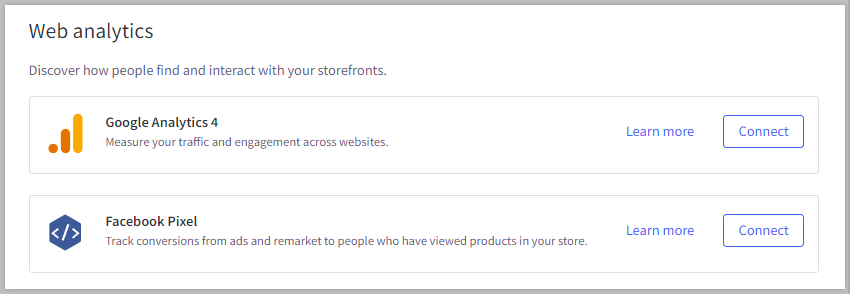The Data Solutions area of your control panel allows you to implement a variety of third-party tracking services, such as Meta Pixel and Google Analytics 4 (GA4), to help you better understand the performance of your storefront and other marketing tools.
Requirements
- To access and manage Web analytics within Data Solutions, you must have the Manage Web Analytics permission enabled on your user account.
- To access and manage Data warehouses and Business intelligence platforms, you must have the Manage Data Warehouses permission enabled.
- To access and manage Customer data platform, you must have the Manage Customer Data Platforms permission enabled.
- To access and manage Web analytics per storefront, you must have the Manage Channels, Edit Channels, and Manage Web Analytics permissions enabled.
Web Analytics
The tools under Web analytics help you to discover how people find and interact with your storefront. To get started, go to Settings › Data solutions and click Connect beside the tool you want to set up.

You can click the Learn more link in the control panel or use the list below for more information about each tool and how it works:
- Setting Up Google Analytics 4
- Meta Pixel
- PayHelm Accounting & Reporting
- Visual Website Optimizer
- Google Search Engine | Verifying Your Site with Google
- Bing Search Engine | Verifying Your Site with Bing
- Setting up Conversion and Affiliate Tracking
If you have more than one storefront, the settings under Web analytics are applied to all storefronts by default, but they can be managed individually per storefront.
To manage a specific storefront’s settings, go to Channel Manager, click Edit storefront settings for the storefront, then click Data solutions from the left navigation. Select Edit from the Action menu for the tool, then check or uncheck the box next to Use global.

Advanced Settings
The data layer is the standard source of information on all actions performed in the browser. Turning it on at the global level applies to all associated storefronts by default.
Click Show advanced settings to access the checkbox for enabling or disabling the data layer. Note that Turn on the data layer must be enabled for GA4 to work, and setting up GA4 will automatically enable it.

Data Warehouses
In the Data warehouses section, connect with a data warehouse to allow you to analyze your data with SQL and connect to your business intelligence (BI) platform of choice for custom reporting and analysis.
BigCommerce has a built-in integration with Google BigQuery. You can also use Skyvia to send your BigCommerce data to all the leading data warehouse solutions such as Snowflake, Amazon Redshift, Microsoft Azure, and more.
Business Intelligence Platforms
Once you have sent your BigCommerce store's data to a data warehouse, you can create custom reports by connecting the warehouse to a BI platform. The Business intelligence platforms section contains Learn more links for several BI platforms:
Customer Data Platforms
Collect events across all sales channels to create a single, consolidated view of the customer. Customer tools in the Customer data platforms section provide insight into how your customers visit and interact with your storefront, allowing you to make informed decisions on customer experience.
FAQ
How can I see if changes were made to my connected data solutions?
In your store’s Staff Action Log, you can see a history of changes to the following data solutions:
- Google Analytics 4
- Meta Pixel
- Visual Website Optimizer
- Site Verification Tags
- Affiliate Conversion Tracking
- Google BigQuery
- Segment.com
The logs provide information on what change was made to the data solution (connection, disconnection, or script update), when the change was made, and which control panel user made it.

Why am I no longer able to set up Universal Analytics (formerly Google Analytics)?
On July 1, 2024, Google sunset Universal Analytics (UA) tracking and stopped supporting historical data. With the tool’s sunset, we removed the Property ID connection option from Data Solutions. The Tracking Code option is still available as some merchants have used this field in the past to insert non-UA scripts and other code into the header of all storefront pages.
However, we recommend removing any scripts from the Tracking Code field and migrating them into Script Manager instead. Script Manager allows you to easily view installed scripts and manage their settings such as header or footer placement, store page location, and script category type.
See Setting Up Google Analytics 4 for details on Google’s current analytics tool.
Why is code I entered under Data Solutions showing on storefront pages?
Improperly formatted code entered into one of the tools under Data Solutions can display as plain text on storefront pages. Check your code formatting and make updates as needed. Consider moving scripts into Script Manager for easier management and access.


